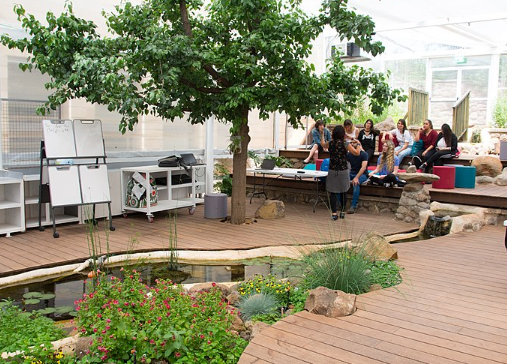 While the concept has been around for decades in classrooms, there are many people who have never heard the term biophilic. While the literal definition itself means the love of life, there is a more meaningful depth to the concept. Biophilia is generally explained as the human desire to interact with nature, and biophilic design is the recognition of how a human’s mental and physical well-being is positively influenced by our relationship with the natural world.
While the concept has been around for decades in classrooms, there are many people who have never heard the term biophilic. While the literal definition itself means the love of life, there is a more meaningful depth to the concept. Biophilia is generally explained as the human desire to interact with nature, and biophilic design is the recognition of how a human’s mental and physical well-being is positively influenced by our relationship with the natural world.
In architecture, biophilic design refers to the incorporation of natural elements into the built environment. This isn’t just a modern philosophy, even centuries ago architects had an innate understanding that we function better when our man-made structures incorporate natural elements. As such throughout history we see many buildings constructed with courtyards, gardens and fountains — restorative elements that give our eyes and busy minds a bit of a respite.
This isn’t just a placebo effect, biophilic design does actual measurable good. The benefits go beyond simply making us feel rested. Many studies have shown positive mental benefits that derive from biophilic design. Natural elements lower our stress, which helps us focus on the task at hand. In addition, these elements restore our mental energy and enhance creativity. This is particularly important in educational settings, as biophilic design has been linked to increases in academic performance.
Because students spend a significant amount of their time in school, shouldn’t their school building and classrooms be designed as calm spaces in which creativity and learning can flourish? But how should school districts’ principals and teachers go about it? Biophilic design is not necessarily difficult to understand or practice in their schools, however some suggestions are more structural and require work to be done during the school construction process, rather than in the present moment. There are ideas that can be easily incorporated into any classroom, however.
The highlighted infographic, Biophilic Design in Education, provides a brief overview of this topic. The main takeaway is that biophilic design goes beyond merely adding plants to the classroom. It encompasses (1) the direct addition of natural elements, such as plants and natural light; (2) the use of natural materials, shapes, patterns and images of nature; and (3) the idea of creating smaller spaces as places of refuge from the larger environment, as exist in nature.
The infographic presents specific ways in which we can bring nature into classrooms. Whether that be providing natural lighting through blinds with views of the outside; creating natural wood structures and furniture to use for students; decorating with artistic wall hangings, rugs and picture panels, colors and textures that evoke nature; and utilizing color patterns in classrooms that are calming and mimic the sky, sun and grass.
Continue reading the infographic from International Woodworking Fair more information about this fascinating topic. Read more on how you can effectively teach your students on https://www.itcpublications.com.au/.

